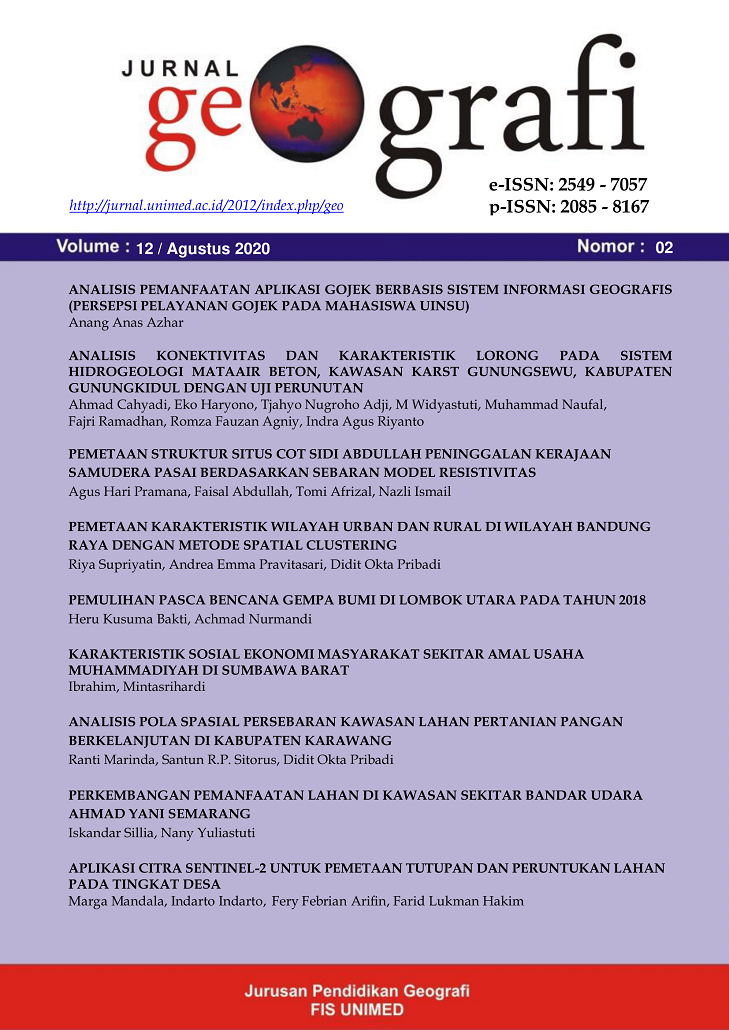ANALISIS PEMANFAATAN APLIKASI GOJEK BERBASIS SISTEM INFORMASI GEOGRAFIS (PERSEPSI PELAYANAN GOJEK PADA MAHASISWA UINSU)
DOI:
https://doi.org/10.24114/jg.v12i02.17214Abstract
Manusia dan teknologi merupakan dua hal yang saling berkaitan yaitu sebagian manusia sebagai pencipta teknologi dan sebagian manusia lainnya sebagai pengguna teknologi. Berkembang dan lahirnya teknologi baru merupakan simbol kemajuan suatu negara karena merupakan suatu tolak ukur dari perkembangan suatu negara sebagai wujud inovasi. Penelitian ini bertujuan untuk mengetahui persepsi mahasiswa Ilmu Komunikasi Universitas Islam Negeri Sumatera Utara (UINSU) Medan mengenai kualitas pelayanan yang dimiliki aplikasi Gojek yang terdiri atas kenampakan fisik, reliabilitas, responsivitas, kompetensi, kesopanan, kredibilitas, keamanan, akses, komunikasi, dan pengertian. Metode yang digunakan pada penelitian ini adalah kuantitatif deskriptif dengan metode pengambilan sampel menggunakan Proportional Stratified Sampling dengan jumlah sampel sebanyak 72 orang mahasiswa. Hasil penelitian menunjukkan bahwa mahasiswa Ilmu Komunikasi Fakultas Ilmu Sosial UINSU Medan telah mempersepsikan aplikasi Gojek sebagai transportasi online yang bagus, baik dan kredible. Dapat dilihat dari hasil data penampakan fisik, reliabilitas, responsivitas, kompetensi, kesopanan, kredibilitas, keamanan, akses, komunikasi dan pengertian telah dinyatakan baik dan bagus oleh pengguna atau konsumen Gojek.Kata Kunci: Persepsi, Kualitas Layanan, Transportasi, GojekHumans and technology are interrelated, that is, some people as the technology creators while others as the users. The emergence and the advance of new technology are the symbols of the development of a country as it is set as a benchmark for the development of a country as a form of innovation. This study aims to determine the perception of the Communication Studies students of Sumatra Utara State Islamic University (UINSU) Medan related to the service quality of Gojek application. The services are physical appearance, reliability, responsiveness, competence, politeness, credibility, security, accessibility, affability, and mutual understanding. The method used in this research is the descriptive quantitative method in which the sampling method using the Proportional Stratified Sampling with a total sample of 72 students. The results show that the students had perceived the Gojek application as an excellent, satisfying and credible online transportation. It can be seen from the results of the statical analysis of the quality of the services have been stated as excellent and satisfying by the users or costumers.Keywords: Perception, Service Quality, Transportation, Gojek.References
A. Zeithaml, V. Parasuraman, A. and L. Berry L. (1985). œProblems and Strategies in Services Marketing. Jurnal of Marketing Vol. 49. (Spring).
Ali, Muhammad. (1982). Penelitian Pendidikan Prosedur dan Strategi. Bandung: Angkasa.
Costabile, M., Raimondo, M.A. & Miceli, G. (2002). A Dynamic Model of Customer Loyalty. Proceedings of the 31st Annual Conference of the European Marketing Academy, 28-31 May, Braga.
Eboli, Laura, and Gabriella Mazzulla. (2007). Service quality attributes affecting customer satisfaction for bus transit. Journal of Public Transportation 10: 21“34
Gaspersz. (2002). Total Quality Management. Jakarta: PT. Gramedia Pustaka Utama.
Kurnia. (2005). Jurnalisme Kontemporer. Jakarta: Yayasan Obor Indonesia.
Mcquail, Dennis. (2009). Mass Communication Theory. London: Stage Publication Ltd.
Rakhmat, Jalaludin. (2011). Metode Penelitian Komunikasi. Bandung: PT. Remaja Rosdakarya.
Ramos, S, et all. (2019). Perceptions of the Public Transport Service as a Barrier to the Adoption of Public Transport: A Qualitative Study. Social Science, MDPI. Soc. Sci. 2019, 8, 150;
Robbin SP, dan Judge. (2008). Perilaku Organisasi. Jakarta: Salemba Empat.
Silalahi, 2017, et al. (2017). Service Quality Analysis for Online Transportation Services: Case Study of GOJEK. 4th Information Systems International Conference 2017, ISICO 2017, 6-8 November 2017, Bali, Indonesia. Procedia Computer Science, Sciencedirect.
Sugiyono. (2012). Metode Penelitian Kuantitatif dan Kualitatif. Bandung: CV. Alfabeta.
Taylor, Brian, Douglas Miller, Hiroyuki Iseki, and Camille Fink. (2009). Nature and/or Nurture? Analyzing the Determinants of Transit Ridership across US Urbanized Areas. Transportation Research Part a Policy and Practice 43: 60“77
Tjiptono dan Fandy. (2001). Manajemen Jasa. Yogyakarta: Andi Offset.
Yin, Robert. (2015). Qualitative Research from Start to Finish, 2nd ed. New York: The Guilford Press
























